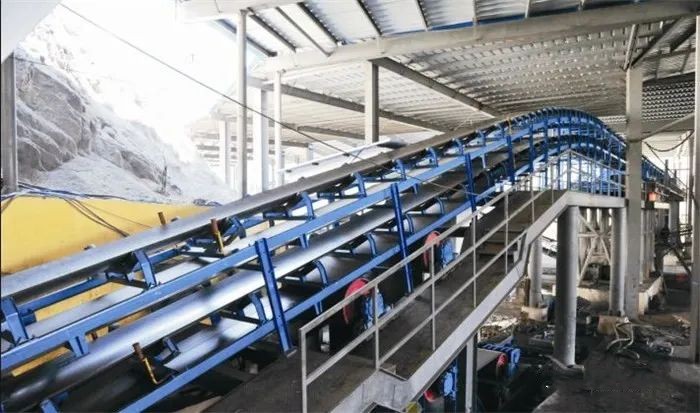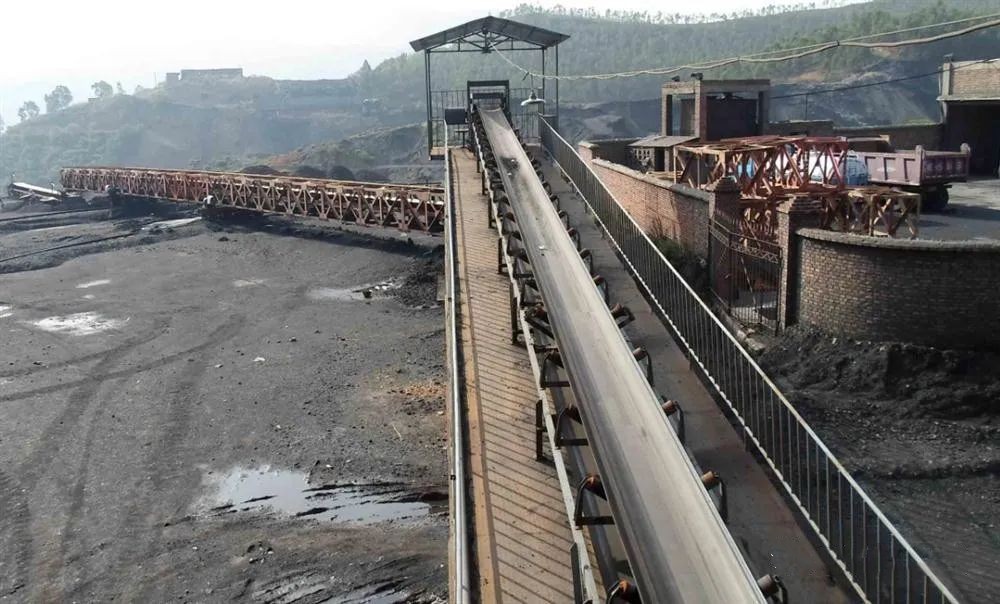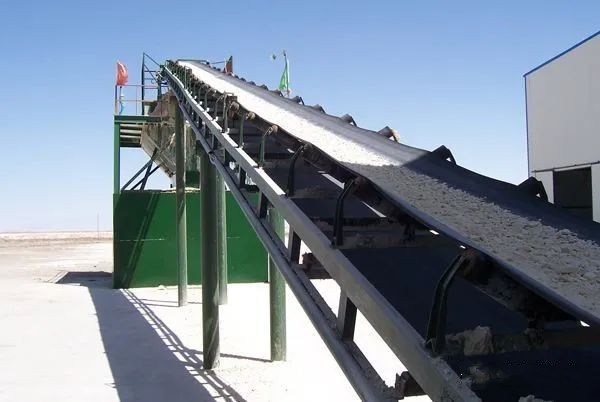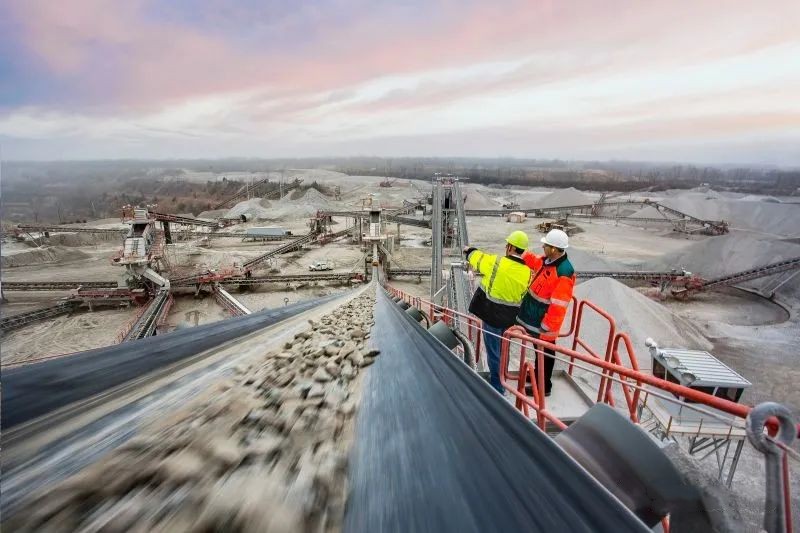What should I do if the belt conveyor slips and affects production? 9 major causes and treatment measures
What should I do if the belt conveyor slips and affects production
belt conveyor
When the belt is running normally, its speed should be the same as the linear speed of the surface of the driving drum, and the belt speed should not be lower than 95% of the linear speed of the surface of the driving drum. However, in actual operation, due to various reasons, the rotation speed of the belt and the driving drum is not synchronized, or the driving drum rotates but the belt does not rotate. This phenomenon is called slipping.
After the belt slips, it will cause the material to flow back and scatter. In severe cases, it may cause belt wear to increase, motor burnout or even belt breakage and other abnormal situations, which will affect the safe and stable operation of the belt conveyor.
The following are the 9 major reasons for the slippage of the belt conveyor and their treatment measures.

1. Insufficient belt tension
If the belt does not have enough tension, there will not be enough frictional driving force between the driving pulley and the belt, and the belt and load will not be able to move.
The tensioning device of the belt conveyor usually includes several structures such as screw tensioning, hydraulic tensioning, weight tensioning and car tensioning. Insufficient stroke or improper adjustment of the screw or hydraulic tensioning device, insufficient weight of the counterweight of the heavy hammer tensioning and cart-type tensioning device, and mechanism jamming will cause insufficient tension of the belt conveyor and cause slippage.
Solution:
1) The belt conveyor with spiral or hydraulic tensioning structure can increase the tension force by adjusting the tensioning stroke, but sometimes the tensioning stroke is not enough, and the belt appears permanent deformation. vulcanization.
2) Belt conveyors with heavy hammer tension and cart-type tension structures can be handled by increasing the weight of the counterweight or eliminating mechanism jamming. It should be noted that when increasing the configuration of the tensioning device, it is enough to add it to the belt without slipping. It is not advisable to add too much, so as not to make the belt bear unnecessary excessive tension and reduce the service life.
2. The rubber lagging of the drive roller is severely worn
The driving pulley of the belt conveyor is generally treated with rubber coating or cast rubber, and herringbone or diamond grooves are added to the rubber surface to improve the friction coefficient and increase the friction force. After the belt conveyor runs for a long time, the rubber surface of the driving pulley and its groove will be severely worn, resulting in a decrease in the friction coefficient and friction force of the driving pulley surface, causing the belt to slip.
Solution:
When this happens, re-latch or replace the pulley. During daily inspections, attention should be paid to the inspection of the drive pulley lagging, lest it cannot be found in time after excessive wear and tear, causing the belt to slip and affect normal operation. .

3. There is water, oil, ice and frost on the non-working surface of the belt
Due to changes in the natural environment, on-site ground washing, equipment maintenance, etc., water, oil, ice, frost and other attachments with a certain lubricating effect adhere to the non-working surface of the belt, and the belt conveyor will accumulate on the surface of the driving drum during operation. , causing the friction between the roller and the belt to decrease significantly, causing slippage.
Solution:
When this happens, first determine the source of the attachment and cut off the source. If it is really impossible to cut off the source, you can sprinkle some rosin powder on the roller, but be careful not to add it by hand, and blow it in with blower equipment to avoid personal accidents.
4. The belt conveyor is overloaded
Due to improper operation or heavy load shutdown, the belt conveyor carries an excessive load during operation, or the belt conveyor is started with load, resulting in overload operation and belt slippage.
Solution:
1) During operation, the current of the belt conveyor and the electronic belt scale should be monitored to control the amount of material and avoid overload operation.
2) Try to avoid heavy-duty shutdown, so as not to exceed the rated load when the belt conveyor starts with heavy load. After the belt conveyor is shut down due to other faults and heavy loads, the starting load can be reduced by manual cleaning.

5. The head drop pipe is blocked
If the blockage of the discharge pipe of the belt conveyor is not detected in time, a large amount of material will accumulate on the head and non-working surface, which will crush the belt and cause slippage.
Solution:
In order to prevent this from happening, the on-duty staff should pay attention to observe the changes of the material on the belt during the operation of the belt conveyor. The occurrence of blockage, even if it cannot be avoided, should try to control the amount of blockage.
6. Part of the conveyor belt is scratched
When a certain part of the conveyor belt is strongly hindered, it will cause the belt conveyor to slip. This kind of situation usually occurs at the head, tail and tensioning device of the belt conveyor, for example, foreign objects are stuck in the feeding pipe of the belt conveyor head and tail, and the redirection roller at the tail does not turn, etc.
Solution:
The monitoring of the current of the belt conveyor should be strengthened during operation. When the current changes abnormally, it should be stopped immediately for inspection, and the cause can be found out and the obstacle can be eliminated before it can be restarted.
7. Failure of slipping speed measuring device
A slipping speed measuring device is generally installed on the belt conveyor. When slipping occurs, it will send out a fault signal and stop the belt conveyor from running. The slipping speed measuring device is mainly composed of a speed measuring wheel and a control box. The speed measuring wheel directly contacts with the belt and is driven by the belt to rotate. When there is sticky material on the speed measuring wheel or poor contact with the belt, the device will mistakenly send a slipping signal to stop the belt conveyor. In actual operation, this situation is more frequent, and the electrical circuit failure in the control box will occasionally send a slip signal by mistake.
Solution:
When the belt conveyor is stopped due to slippage, it should first be checked on site to determine whether the belt conveyor has really slipped. If the skid signal is sent by mistake due to the speed measuring device, it should be checked and dealt with. The general method of treatment is to remove the sticky material on the speed measuring wheel, adjust the position of the speed measuring wheel and troubleshoot the electrical circuit.
8. The brake cannot be opened when starting
When the belt conveyor is started, sometimes it will slip and stop because the brake cannot be opened. The reason is that the driving device of the belt conveyor cannot rotate due to the brake. and its driving device do not work.
9. The wrap angle or friction coefficient between the drive wheel and the belt is too small, usually the wrap angle between the drive wheel and the belt should not be less than 120°, if it is too small, it will easily cause the belt conveyor to slip.
Solution: If the wrap angle between the driving wheel and the belt is low, and the adjustment of the position of the tensioning wheel still cannot effectively increase, the design may need to be modified. Therefore, these factors should be carefully considered in the early design to ensure the design quality of the belt conveyor. If the problem is discovered during assembly and debugging, it will be very passive to modify the design.
In addition, if the friction coefficient between the driving wheel and the belt is too small, it will also cause the belt to slip.
Solution: Carefully observe whether the surface of the conveyor driving wheel is too smooth, otherwise use a knurled structure or inlay a layer of rubber before testing.

The slippage of the belt conveyor brings great hidden dangers to safe production and operation. Therefore, it is necessary to strengthen the management system in all aspects, improve the maintenance level, ensure the reliable operation of the equipment, and improve the production efficiency. After the fault occurs, the above method can be used to accurately judge and deal with it, so as to ensure the safe and stable operation of the belt conveyor system.
 O'zbek
O'zbek slovenský
slovenský Azərbaycan
Azərbaycan Қазақ
Қазақ Latine
Latine ລາວ
ລາວ български
български नेपाली
नेपाली فارسی
فارسی Javanese
Javanese Українська
Українська Lietuvos
Lietuvos Română
Română Slovenski
Slovenski پښتو
پښتو Punjabi
Punjabi Bosanski
Bosanski Malti
Malti Galego
Galego Afrikaans
Afrikaans Esperanto
Esperanto 简体中文
简体中文 Српски
Српски मराठी
मराठी Ελληνικά
Ελληνικά čeština
čeština Polski
Polski ไทย
ไทย Nederlands
Nederlands Italiano
Italiano Tiếng Việt
Tiếng Việt Deutsch
Deutsch français
français русский
русский Português
Português Español
Español 한국어
한국어 Svenska
Svenska Malay
Malay اردو
اردو norsk
norsk Indonesia
Indonesia عربى
عربى Gaeilge
Gaeilge Türk
Türk Pilipino
Pilipino हिन्दी
हिन्दी Dansk
Dansk বাংলা
বাংলা English
English


What is a Metering Conveyor
In modern material handling systems, efficiency and precision are critical to maintaining smooth operations. Among the many specialized conveyors used in industries such as packaging, food processing, mining, and logistics, the metering conveyor plays a vital role. But what exactly is a metering conveyor, and why is it becoming increasingly important in production environments?
Read MoreJuli Engineering Gains Global Recognition Among Mining Conveyor Manufacturers
The mining industry relies heavily on efficient material handling systems to ensure productivity and safety in large-scale operations. Among the many solutions available, mining conveyors stand out as indispensable equipment for transporting bulk materials such as ore, coal, and aggregates. As demand for advanced solutions grows, Juli Engineering has established itself as one of the most reliable mining conveyor manufacturers, offering durable, high-performance systems tailored to global mining needs.
Read MoreDesign and Application of a Comprehensive Coal Spillage Handling System for Downwards Transportation Belt Conveyor
A belt conveyor with an annual production capacity of 3 million tons is installed in a main inclined roadway with a steep angle of 22°. During operation, issues such as coal overflow, spillage, and falling coal occur, particularly when transporting raw coal with high moisture content.
Read More